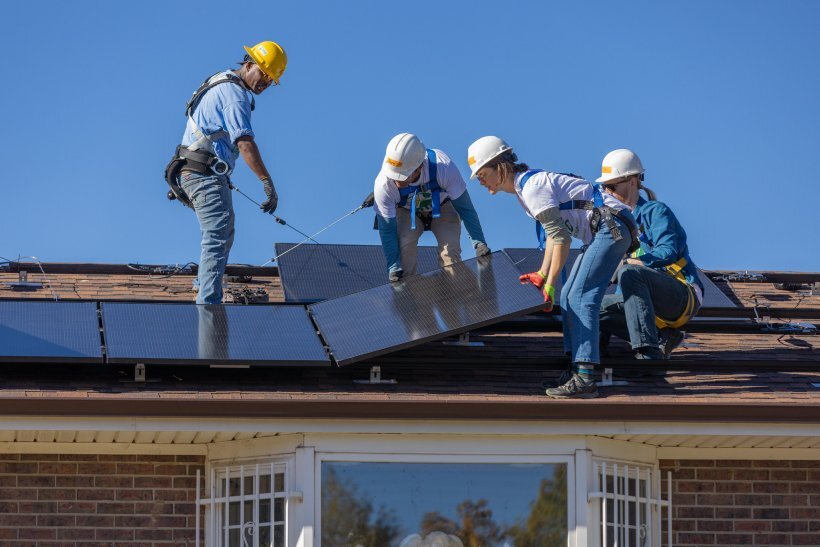Wondering if rooftop solar panels are worth the cost? There are many factors to consider, but if your home is a good candidate, here are some of the potential cost benefits.
Source: U.S. Department of Energy Office of Energy Efficiency and Renewable Energy, “Energy Saver”
Rooftop solar can:
✔️ Reduce your energy bills. By generating your own electricity, you can reduce or even eliminate your monthly electricity bills, helping you recoup the initial investment within 5–10 years, typically.
✔️ Increase your property value because homes with solar energy systems often have higher property values and sell faster.
✔️ Make you eligible for federal tax credits, as well as other incentives, rebates, and tax credits at the local level.
By investing in rooftop solar power, you can not only save energy and money but also reduce greenhouse gas emissions and promote sustainable energy practices.
Lowering electricity bills is one of the main reasons why consumers may decide to install rooftop solar panels. Every household is different—from the size of the home, to the number of people living in it, to the electricity needs of those people, to where the buy their electricity—so calculating an average amount of savings from going solar is nearly impossible. This U.S. Department of Energy (DOE) Solar Energy Technologies Office (SETO) blog post will walk you through calculating the solar payback period, or how long it takes for a rooftop solar system to pay for itself. When calculating the amount of potential savings, there are several factors to consider.

The Amount of Electricity You Produce
First, assess your home’s solar rooftop potential. If there are trees near your home that create excessive shade on your roof, rooftop panels may not be an option. The size, shape, and slope of your roof are also important factors to consider. Typically, solar panels perform best on south-facing roofs (anything between southeast and southwest) with a slope between 15 and 40 degrees, though other roofs may be suitable, too.
The Amount of Electricity You Consume
Check your utility bill to find out how much electricity you consume on average every month. The Utility Rate Database maintained by the DOE Energy Information Administration shows current electricity rates in your area. Your solar savings will also depend on how much the utility will compensate you for the excess solar energy you send back to the grid. This is different for every utility.
How You Finance Your System
The Lawrence Berkeley National Laboratory’s Tracking the Sun report contains residential solar installation costs around the country, which can help you expect how much to pay. There are several options for how to finance your system.
If you pay cash for your solar system, the payback period refers to the length of time required before the system has paid for itself and all future power produced is free. You can get a personal loan with fixed interest rates and monthly payments. Another option is to use a power purchase agreement, or PPA, which means you do not own the solar panels on your roof but still benefit from the clean power it produces. In both of those cases, you may have immediate savings on what you pay for electricity.
Incentives
If you buy or take out a loan for a solar system, you may be eligible for the federal residential solar energy credit, which is a tax credit that can be claimed on federal income taxes for a percentage of the cost of a solar photovoltaic (PV) system. If you financed your system through a power purchase agreement, the owners of the system would be eligible for tax credits, which they could pass along to you in the form of a cheaper bill. In some instances, these third-party system owners can receive additional credits not available to homeowners, which can lower your bill even further.
Many states also have incentives for rooftop solar customers. The Database of State Incentives for Renewables & Efficiency, known as DSIRE, is the most comprehensive source of information on incentives and policies that support renewable energy in the United States. By entering your zip code, DSIRE provides you with a comprehensive list of financial incentives and regulatory policies that apply to your home. The database is operated by the N.C. Clean Energy Technology Center at N.C. State University and was funded by DOE.
Doing the Math
Companies like EnergySage—a former SETO awardee—can help you figure out how much you will spend and ultimately save by going solar. According to EnergySage, “you can calculate your break-even point, or solar payback period, by dividing the final cost (the total cost of your solar panel system minus any upfront incentives) by your annual financial benefit (the amount you save on electricity combined with annual incentives). The faster the cost of electricity increases, the shorter your payback period and the greater your savings will be.”
Any solar installer should be able to help you with these three steps:
Step 1. Subtract any upfront incentives from the total cost of your solar panel system.
Step 2. To calculate the amount you save on electricity, multiply the average monthly cost on your utility bills by 12 to get your annual savings. Subtract any annual incentives according to your solar installer.
Step 3. Divide your answer from Step 1 by your answer from Step 2 for your solar payback time in years.
While payback time is a good indicator of savings potential, for a complete picture you need to compare your solar savings to other low-risk ways you could have invested your money over the time horizon that is important to you. The following table shows the annual after-tax rate of return you would need to earn on the alternate investment for it to match your solar savings, for three typical payback times:
| 4-year payback time | 6-year payback time | 8-year payback time | |
| 10-year planning horizon | 10.8% | 6.4% | 3.4% |
| 20-year planning horizon | 9.7% | 7.5% | 6.0% |
*2.5% annual inflation, no cost for maintenance, no effect on insurance, no increase in resale value.
When the payback time is less than 10 years, most homeowners find that an investment in solar power is financially more attractive than any other low-risk investment they could make over the time horizon that’s important to them. And this does not even include any increase in the resale value of the house due to the solar panels, which a DOE study found to be significant.
When Rooftop Solar Isn’t an Option
Community solar allows customers to either buy or lease a portion of the solar panels in a large solar array located in their community. Community solar customers typically receive an electric bill credit for electricity generated by their share of the community solar system—similar to someone who has rooftop panels installed on their home, but without the upfront costs or the need to own your roof.
Examples
While it’s impossible to articulate every scenario where someone would save money going solar, we’ve put together some examples that illustrate savings based on their location and type of purchase:
- A doctor in California who owns her home decides to purchase a rooftop solar panel system for approximately $15,000 with cash and receives a 30% tax credit. She can expect to save around $200 per month on her electricity bills and pay back the cost of the system in less than 5 years. Her return on this investment is equivalent to having put the same money into stocks that gained 7% per year over this period. And after this pay-back period, her solar electricity is free.
- A mid-income Ohio family of four chooses to lease solar panels on their partially shaded roof. They’ll have fixed monthly payment of $100 on the panels and avoid paying $150 per month on their electricity bill, for a net annual savings of $600.
- A young couple in New York takes out a solar loan to install solar panels and extra mounting equipment on their flat roof. With no down payment on the loan and monthly payments of $150, the family plans to pay off their loan in eight years while saving $220 per month on electricity.
- An apartment renter in Washington, D.C. .subscribes to an offsite community solar system. He saves $42 per month and can transfer the energy savings to his next residence if he moves.
- A teacher in Hawaii .takes out a loan for a solar+storage system, making monthly payments of $150. With $275 per month in savings from the system, she nets $125 per month in savings and the battery provides additional resilience against power outages.
Check out the Homeowner’s Guide to Going Solar and Smart Shopping Tips for Going Solar.






